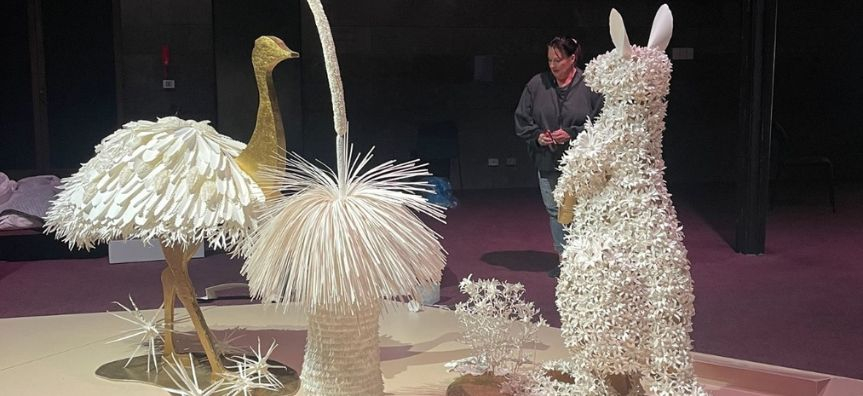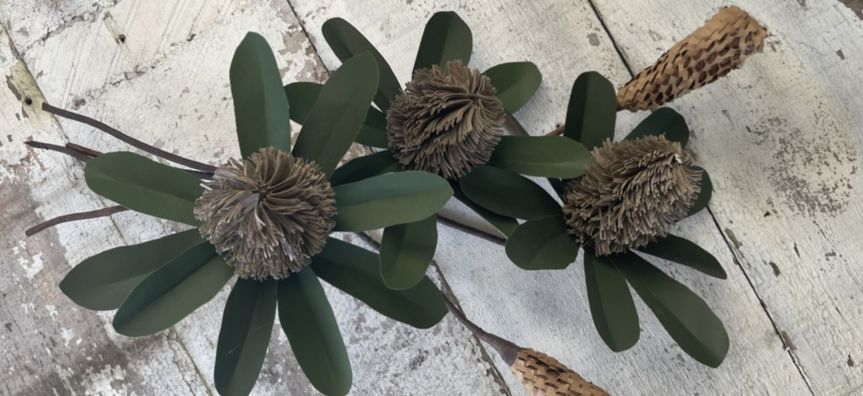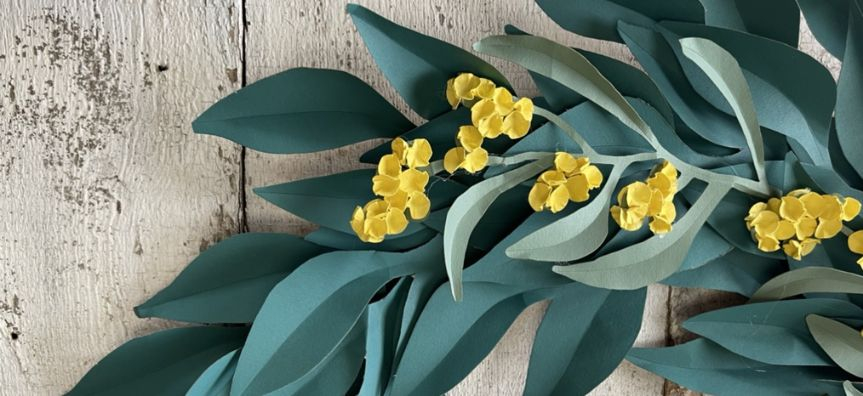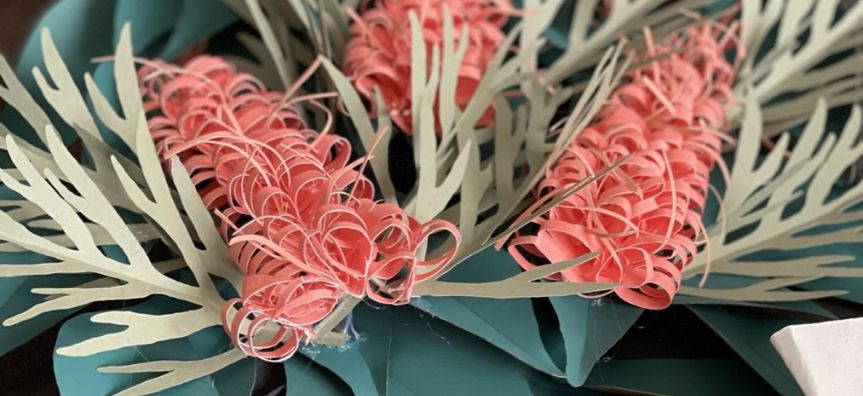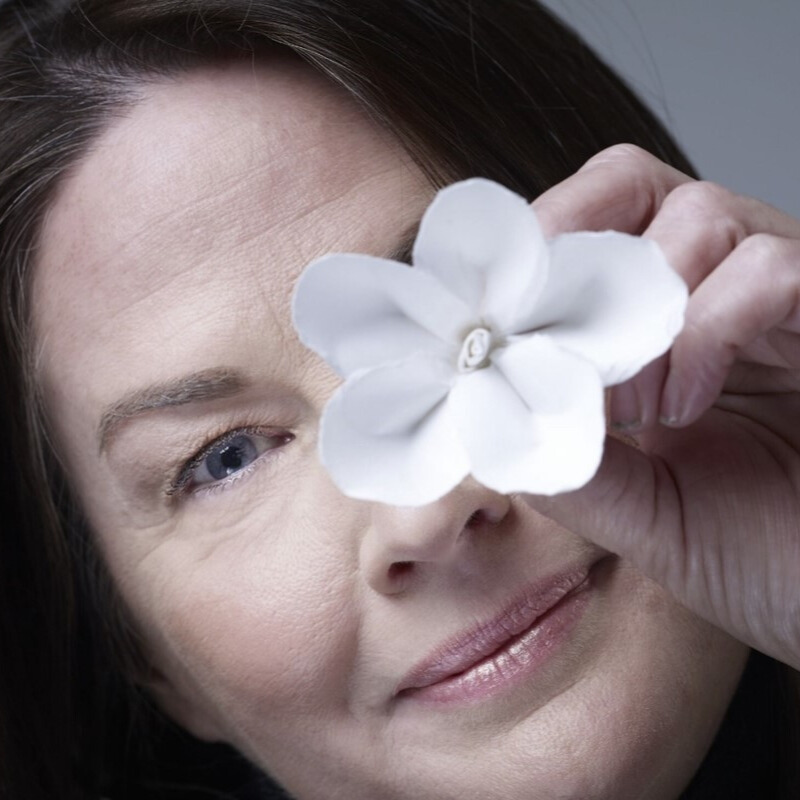
Local Creative - Jo Neville
Jo Neville creates papered worlds. She is the artist and designer behind Paper Couture, a creative practice operating since 2000. With varied collaborators including fellow artists and high-end brands such as Louis Vuitton, Tiffany & Co, and Moet Chandon, Jo also works on private commissions and sells a range of paper products.
Where possible, Jo engages in her local environment, making paper artworks that tell the story of the area she is located using paper as the main medium. Jo specialises in paper native blooms found on the northern beaches, including banksia, bottlebrush, flowering gum, waratah, flannel flowers, wattle, and xanthorea.
Jo Neville is the 2024 resident artist at Council’s Mona Vale Creative Space Shop. Follow Jo on Instagram for updates on the shop and workshops across the year.
When talking about your participation in the recent Art of Bloom exhibition at the National Gallery of Victoria, you described a beautiful full-circle moment:
In 1984 your dad took you to a performance in the Great Hall at the NGV. While watching a “very avant-garde dance” you became enamoured with the paper costumes worn by the German dance troop, deciding then and there you were going to be a paper artist. 29 years later, your paper creations were on display in that same hall!
What other influences have led to your current artistic practice?
You can’t go past family as inspiration, well not mine you can’t! I was nurtured creatively as a kid. My Mum grew up in a generation where creativity wasn’t good for a career or family. According to her parents, Mum was also “not good enough” as an artist. So, we were encouraged to do after-school classes in creativity rather than sport! However, I was a competitive swimmer, and a lot of squad training was included in that.
I went to an amazing secondary school in Melbourne that was known for its art faculty. Nothing shocked our teachers. We had one teacher for art history and one for practical art. They nurtured our whims and aspirations, guiding us to creative fields beyond the typical secondary school levels. Education was so vital and inspiring for me—a gift from my parents.
Afterward, I found myself selected to study Graphic Design at Swinburne University, the most prestigious graphic design course in the country at the time (you were chosen back then!).
It was 3-4 gruelling years, but it was training like no other. For example, my 3D lecturer, Helmet Lueckenhausen, challenged us to design, problem-solve, and engineer with paper and cardboard. It was so outside the square! Curiously, this was my worst subject. Thinking back now, I’m astounded to think I became a maker using all those paper engineering skills!
Starting as a graphic designer, (in your own words) “before computers”, you’ve described the challenges of working to clients’ restrictions.
What have you carried across from graphic design, and how do you feel about restrictions in your current creative practice?
It goes something like this:
- Deadline - usually set in stone. You never take on a job if you can’t meet the deadline - ever!!!
- Brief – who they are and what you have to do (colour palette/location/demographic/logistics/research).
- Budget – this is where the guessing game starts. What you are worth vs. what is realistically affordable? How can you offer the best materials and fabrication process that meet the brief and deadline?
- Design aesthetics – this comes from practice.
This is what I brought across from my Graphic Design training. You learn to work within the restraints of client demands. It takes training, practice, and knowing how to read a room. You learn to know what you need to bring to the table.
It seems you’re very connected to the environment around you and draw inspiration from it. Either walking through the National Park surrounding the Q Station, or diving at Shelly Beach.
What are some of your favourite places to find inspiration in the Northern Beaches, and how does this translate into your work?
My work is ‘site-specific’ (this is such an artist’s term!). It reflects my location and connects to where I work, live, and play.
We can’t help but be inspired by our urban landscape, the natural environment, and the history of a place. Combined, these elements help us tell stories and connect to the community where we create. It’s almost like interpreting a brief - that is the commercial artist in me!
I interpret my surroundings through the colours I use and the subjects I respond to, including flora and fauna specific to the region. Inland on the Northern Beaches is as beautiful as the coast, however as a swimmer, I love being inspired by the water I rejuvenate in. Having worked at the Q Station, it has also become a passion of mine to delve into the history of the area.
I love getting involved with local businesses, like The Harbord Diggers, Bendigo Bank, Harris Farm, and Q Station to name a few. I find ways to help them create community and environmental awareness through how they address event design and market themselves. For example, reusing and repurposing decorations for their events.
You’ve had many exciting collaborations, from working with big-name brands - like Louis Vuitton, Tiffany & Co, and Moet Chandon – to projects with fellow local creatives like Glenda Davis (aka Written by Hand).
What do you think is the key to a successful collaboration, both client-artist and artist-artist collaborations?
I have collaborated with some of the best brands in the corporate world. However, it is more important, or more fitting, to collaborate with like-minded creatives such as Glenda Davis from Written by Hand who grew up on the Beaches.
It is far more ‘give and take’ with like-minded creatives, rather than big brands who can be ‘take take’. Often, I have to sign a Non-Disclosure Agreement so I can’t share any work I have been commissioned to do for the big brands – gutting as an artist!
Artists tend to be more supportive of each other, helping with problem-solving and connections to other creatives who may be able to help. Of course, some artists can be guarded (that can be a creative thing – not showing all your cards). We have some amazing artists on the Northern Beaches who are so open, and I adore them.
Once I’m working in the Mona Vale Creative Space, I look forward to collaborating with locals – both creatives and businesses.
Sustainability is important to you. How do you consider the environmental impact of your work when creating new projects?
I usually source papers that have been produced from sustainable ‘raw virgin’ materials for my corporate projects. One paper I often use is called ‘Extract’; a paper produced in Europe from used coffee cups. If we made great sustainable papers commercially in Australia, I would be all over it. Unfortunately, we don’t.
I design, or rather engineer my installations or artworks with reuse in mind. More than anything, I hate when the elements I produce are single use. I make my work to be remade and reused if the artworks allow. Always more than once!
If a company can no longer use the artwork, I ask that they give them to a hospital, hospice, or early childcare centre. Or I can simply pick them up and reuse the materials.
If I can, I will repurpose papers we have on hand - old books, maps, shopping packaging (often packaging from a high-end brand is great quality paper). A brand can make me work outside my creative comfort zone by determining the colour palette with their packaging. For example, I made a xanthorrhoea (grass tree) out of Mecca packaging last year, pushing me to use a colour palette I would never have considered. I created an environmental artwork that was spectacular.
In your interview with Better Homes & Gardens (2018), you said: “I love abusing paper”. What is it about paper, and your cruelty towards it, that you love? Are there other materials or mediums you enjoy working with?
I do love abusing paper! Think about the worst thing you can do to paper - you can tear it, scrunch it, soak it, or as I say in my workshops, “drown it!”. I have perfected these techniques to create my artwork. For example, by tearing, which is a favourite technique of mine, I exaggerate the edge of the paper with beautiful, decked edges. Changing something of one dimension into three, that is the magic of paper engineering.
Paper is not as fragile as we all think. Every artist who works on paper, or with paper, is damaging the surface to make their marks. To create beautiful artworks, be it pencil and charcoal, or watercolour on the most divine textured watercolour paper - these are all techniques that change, or as I say, ‘damage’ the surface of the paper.
I do use other materials and regularly combine these into my installation work. This is often determined by the client brief. Fabric, wire, thread, and natural ephemera are often incorporated into my work.
Papered House (2019) was a full-scale takeover of a heritage-listed worker’s cottage at the Q Station in Manly. You recreated domestic objects that brought the building to life, from paper teacups and tea towels to detailed quilts on beds. On the other end of the spectrum, you create delicate posies of flannel flowers for special moments.
How do you approach projects of such different scales, and do you have a preference?
My preference is definitely large. As they say, “Go big or go home!”. If not large pieces, I often have to fill a large space; 750 handmade paper flowers for the walls of The Magic Millions marquee, 1,500 origami style flowers for an enormous chandelier hung in a heritage building for Louis Vuitton, or 9,000 blooms for indoor garden beds at Tiffany & Co’s Melbourne store.
If choosing volume or scale, I would pick scale. My favourite flowers, which I will be hanging in the Mona Vale space, are the largest I have made. These flowers were used for a window display at Birken Head Point seven years ago and have been used around eight times since.
There is something beautiful about working on an object that you’re not sure is going to work until after you’ve made it. You need faith in the skills you have practiced all these years to achieve what you set out to do. It is also about knowing what your material can do.
We’re excited that you’re taking up residency for the year at Council’s Creative Space Shop in Mona Vale.
Your previous studio has been described as ‘a world made of paper’. What can people expect to see when they enter your shop in Mona Vale?
I plan to create a paper florist where colour and blooms will change with the seasons. I will be incorporating some of my old paper props, along with my blooms, to create once again ‘a world made of paper’. I love nothing more than engaging with visitors to my store and creating a dialogue of creativity, storytelling, and genuine conversation with each visitor.
Single blooms or bunches will be for sale, along with curated artworks. I will also be selling all the materials needed to make my blooms.
You’ve hosted many workshops on creating paper flowers and other forms. Apart from a beautiful hand-crafted object, what do you think people get out of your workshops, and will you be hosting any at the Mona Vale Creative Space Shop?
I believe everyone can create; you just need to be shown how. So, I teach step by step, as we were taught to read and write in our childhood. Creativity is great for your soul. There is something to be said for working with your hands and how it can take your mind away from everyday stresses.
We will have workshops at Mona Vale. They will be either express single-bloom classes or more intense masterclasses, with some guest teachers adding to my classes. A kit is supplied with quality materials and tools, so all students need to do is book and turn up with their willing hands. Then the magic begins!

